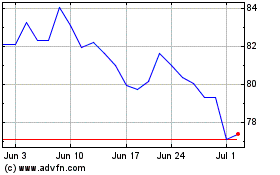By Peter Loftus and Melanie Evans
Intensified manufacturing efforts aren't moving fast enough to
meet the rising U.S. need for ventilators that can keep critical
coronavirus patients breathing, hospital and medical-device company
officials say.
A frantic global effort is under way to manufacture more of the
breathing machines. Traditional ventilator makers including
Medtronic PLC and Hamilton Medical AG are more than doubling their
weekly output. New entrants Ford Motor Co. and General Motors Co.
have promised a few thousand ventilators as early as this month
before sharply ramping up manufacturing.
The federal government has also taken steps to find and
distribute ventilators, shipping ventilators from its strategic
stockpile and the Federal Emergency Management Agency.
Yet the reinforcements aren't likely to arrive soon enough and
in sufficient numbers for U.S. hospitals confronting a surge of
cases or gearing up for the next wave, hospital and medical-device
industry officials say.
Hospitals in the U.S., which have about 60,000 ventilators on
hand, will be about 25,000 short of what they need when the surge
in coronavirus patients peaks around the middle of this month,
estimated Neil Carpenter, who consults for hospitals at Array
Advisors.
"I really need them now," said Chris Van Gorder, chief executive
of Scripps Health, which operates five hospitals in San Diego
County, Calif.
Scripps placed a roughly $1 million order for 30 ventilators in
early March, Mr. Van Gorder said. Yet delivery is scheduled in
eight to 10 weeks, which is likely too late, Mr. Van Gorder said.
Without the new orders, doctors are preparing to use one ventilator
for two patients.
Scripps also hopes to secure more ventilators from San Diego
County, which placed its own order. The county hasn't yet received
a delivery date, according to its procurement office.
Hospitals outside the U.S. are also struggling with an
insufficient number of ventilators on hand and being delivered.
Ventilators, complicated machines often the size of a desktop
printer, have emerged as a crucial weapon in hospital coronavirus
treatment. They are used to aid critically ill coronavirus
patients, whose infections have all but overwhelmed their lungs and
choked off breathing. Many don't survive even after being hooked up
to one.
Hospitals, which typically use the devices on premature babies
and pneumonia patients, didn't have enough of the machines to cope
with the influx of coronavirus patients. As their demand jumped,
facilities said they searched frantically for ventilators to fill
mounting needs.
Northwell Health, in New York City and the surrounding region,
is converting up to roughly 270 anesthesia machines and outfitting
about 350 other devices with 3-D printed parts so they can function
as ventilators, a spokesman said. It is waiting on an order for
more than 500 ventilators placed weeks ago to be totally fulfilled,
said Phyllis McCready, who oversees the health system's supply
chain.
On Friday, New York Gov. Andrew Cuomo signed an executive order
allowing the National Guard to take ventilators from hospitals in
areas of the state that don't have a lot of cases, and redistribute
to hospitals in need.
Manufacturers are ratcheting up production. Yet companies say it
takes time to move employees around, add production lines and
arrange a supply chain for the hundreds of components in each
machine.
Altogether, medical-device manufacturers are making on average
2,000 to 3,000 ventilators per week, compared with 700 per week
before the crisis, said the Advanced Medical Technology Association
industry group. It expects production to increase to 5,000 to 7,000
ventilators a week in the coming weeks.
"We could double or triple capacity and still not be able to
meet global demand," said Eric Honroth, head of North America for
Getinge AB, a Sweden-based maker of ventilators that is moving to
increase production by 60% to make 16,000 ventilators this
year.
General Motors is working with ventilator maker Ventec Life
Systems to make 10,000 machines a month, and possibly up to 20,000,
but it would take till late spring or summer to reach full
capacity.
General Electric recruited about 100 current employees and
retirees in the region to raise production at its Madison, Wis.,
plant. It has been training the new plant workers before giving
them jobs like quality inspection, material handling or filling a
spot on the manufacturing line.
Medtronic, which is transferring employees from a pacemaker
plant to its nearby ventilator factory in Galway, Ireland, plans to
double production by the end of this month and make an estimated
30,000 ventilators in the next six months, said Bob White, head of
the company's minimally invasive therapies unit.
The company also took the unusual step of sharing online the
designs for one of its ventilator models, so other companies could
make the model. By Thursday, the designs had been downloaded more
than 84,000 times, a spokeswoman said, though the company wasn't
aware of any firm plans by others to make the machines.
Florida-based hospital operator AdventHealth, which projects the
pandemic will peak across its markets in starting in May, is
exploring whether it would be able to get excess ventilators from
hospitals after they have passed their peak needs, officials at the
operator said. Meantime, it struck deals Thursday with three
ventilator manufacturers who pledge to deliver equipment starting
this month and into May, said Marisa Farabaugh, the system's supply
chain chief.
--Thomas Gryta, Denise Roland and Mike Colias contributed to
this article.
(END) Dow Jones Newswires
April 04, 2020 12:42 ET (16:42 GMT)
Copyright (c) 2020 Dow Jones & Company, Inc.
Medtronic (NYSE:MDT)
Historical Stock Chart
From Mar 2024 to Apr 2024

Medtronic (NYSE:MDT)
Historical Stock Chart
From Apr 2023 to Apr 2024
